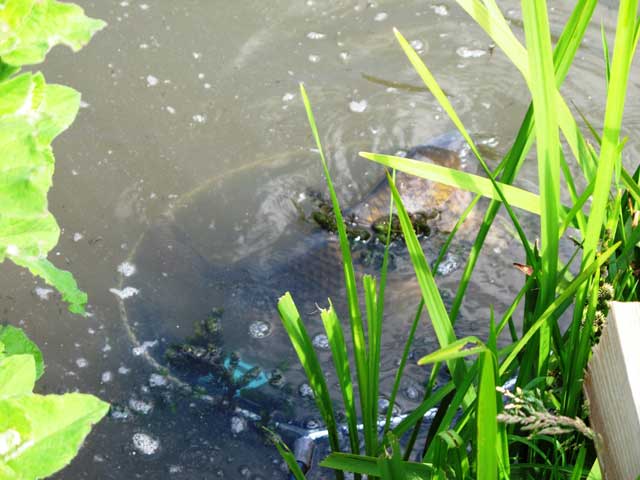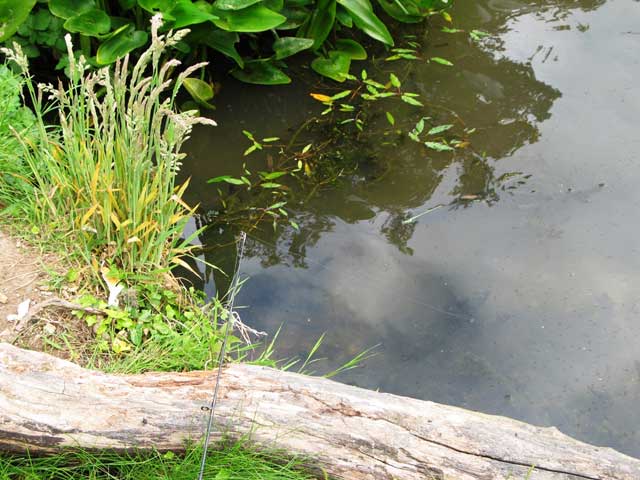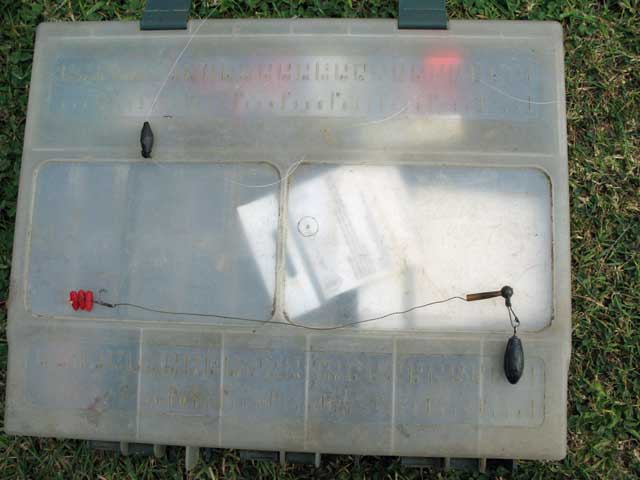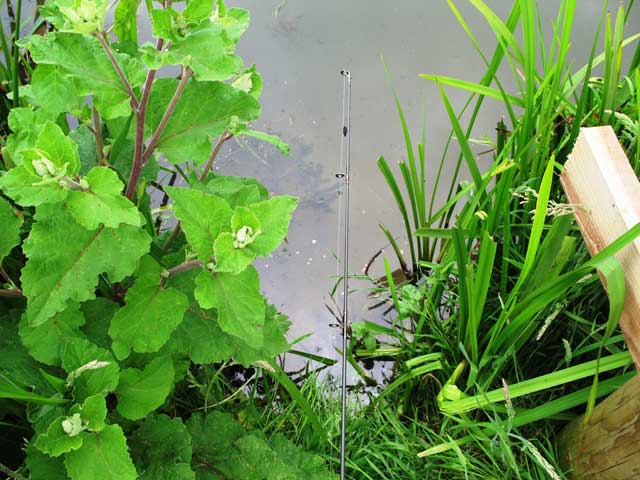You may remember a short article I wrote last year about fishing for carp in a Cornish mill pond. Well I was back down there again in late June and, with a sea like a mill pond putting an end to any hope of surfing, I had to resort to fishing in the other mill pond!

The Mill Pond
The successful method last year was float fishing in the margins and, sure enough, on my first short session this method soon resulted in several commons up to about 7lb. Now I’m not one for easy fishing and when I quickly caught a couple of medium sized carp on my second session I paused for a while to consider a new challenge. The carp in this lake go up to mid doubles with the two biggest to my knowledge being 14lb and 16lb and I’d seen a couple of big fish enter my swim, but they hadn’t stayed for long. I decided to move to a swim where I had a bit more cover and see if I could suss out what the problem was.
At the top end of the lake I found a small gap between the bank-side vegetation and a wooden fence. The gap was just wide enough to poke my rod tip through and there was enough cover to allow me to peer down into the limpid water without being seen. I lowered my float by hand into the swim, dropped a handful of pellets around it and settled down full length on my stomach to observe. Within minutes a shoal of the resident rudd were rooting around and this activity soon attracted a carp, which entered the swim from the marginal weed to my left. The fish gave my float a wide berth and left the swim to my right. Shortly afterwards a beautiful pale common in mid double figures approached from the centre of the pond, bristled visibly about 6ft away from my float, turned on its tail and left hurriedly. It looked very much like the fish were wary of the line coming down from the float.
Off came the float and I set up again with a small ledger and a lump of tungsten putty moulded around a power gum stop knot about 18 inches above it. I lowered this new set up into the swim, pulled everything straight and fed a little slack so the line from the rod tip followed the slope of the margins. I then fed another handful of pellets and settled down again to watch. I’d not long to wait before a large carp entered the swim and started to browse on the few pellets that had settled on the steep marginal slope. It was feeding in less than a foot of water with its back just breaking the surface about 18 inches from my nose. I held my breath, willing the fish to follow the trail of pellets down the slope to my bait. The line from the rod tip twitched violently as the fish brushed against it, but it didn’t spook. The back of the fish sank lower in the water and I held my breath again. Surely it was now only a matter of time before it found my bait, but no, the carp turned and slowly drifted out of the swim.
This was repeated several times over the next half an hour, with the same large fish feeding on the marginal slope, but not dropping down on to my main feed. Before I had time to hatch another plan, my rod tip was pulled violently round as another, slightly smaller, carp realised its mistake and powered out into the lake. This fish weighed around 9lb and it led me a merry dance around the swim, putting an end to any hope of further action.

It led me a merry dance
I wandered off to the other end of the lake where I spotted a few decent fish cruising just off a weed bed. Here the lake was shallow and silty, with large patches of weed. Close to the bank was a clear area and I fed a few pellets and sat back to watch. The fish soon drifted over and began to feed, churning up the silt and clouding the water. Given my success in the other swim I was very confident as I lowered a 10mm boilie into the cloudy water. I sat back to wait for the inevitable take, but it never came and I experienced a seriously frustrating hour during which the carp still continued to feed and despite trying all the baits I had in my bag and ringing the changes with my rig I failed to catch.

Close to the bank was a clear area
This failure to catch niggled me all evening. It couldn’t be preoccupation as I’d tried small pellets on the hair and still didn’t catch. It could only be that somehow the fish weren’t taking the bait into their mouths, maybe it was the weight of the hook. Hmm….
Next day, I made my excuses and wandered down to the lake. There were still fish cruising in the shallows so I fed a few pellets in the margin where I’d fished yesterday and wandered up the bank, to experiment with buoyant baits. I rooted around in my tackle box and assembled an assortment of artificial baits which had accumulated over the past few seasons. The choice boiled down to corn, maggots or casters and I decided to give casters a go as the carp might be less wary of them. I threaded casters on to the hair, dropping the rig in the margins after each caster to check how it behaved in the water. It turned out that 3 casters were just enough to let the hook sink slowly, so I fitted a hair stop and returned to the shallows.

My rig
The carp were still feeding happily, churning up the bottom, heads down and tails waving happily on the surface. I fed a few more pellets then lowered my rig into the swim. Bingo! I hadn’t even got the rod back on to the ground when I had a violent take from a decent carp.
That was one problem solved, but I still had a score to settle with the fish that had ignored my bait yesterday. This time I decided to set up my bait on the marginal slope before feeding. I removed the ledger weight and wound in until the rig putty was just below my tip ring. I set my rod on the ground so that the casters just touched the bottom about 6 inches below the surface and the line draped along the slope. I was now effectively free lining the casters 18 inches from my rod tip.

Free lining the casters – note the rig putty just below the tip ring
I was just holding out my arm to drop a few pellets into the swim when the carp drifted into view. We both froze. The fish could obviously see me, but it didn’t look too worried and I waited until it drifted away before dropping the pellets. I was now prepared for a long wait, but within 10 minutes I saw the back of the carp appear in the gap. I was lying full length on the grass and my face was now no more than a foot from the back of the fish. Its scales gleamed in the sunlight, dark bronze flecked with buttery gold. Out of the corner of my eye I saw the line twitch, then the rod tip lunged downwards and I was deluged in water as the fish did a back flip and set off for the other bank at top speed. This fish pushed my light travel rod to its limit as I struggled to control it in the tight confines of the swim, but eventually I managed to bundle it into my net. It was one of the bigger fish and looked to be around 12 ½ lb.
Over the next few days I had several more decent fish, all on the artificial caster and some caught only inches from the bank.
Lessons Learned
• Even on easy waters carp can be very aware of your line and it pays to think about how you present your bait. Pinning the line to the bottom and leaving some slack ensured that these carp fed confidently and were able to brush against the line without spooking.
• It would have been easy to carry on float fishing and catch loads of small to medium fish, but by modifying my tactics slightly I was able to catch some of the bigger carp.
• If you’re getting line bites and the fish are obviously feeding in your swim it pays to think carefully about your presentation. In this case the fish were obviously not ignoring my bait, but failing to pick it up due to the weight of the hook. By fishing a buoyant bait which counteracted the weight of the hook it was hovered up along with the free offerings.
• I’ve been a little sceptical about how good artificial baits really are, but later in the week I caught a decent carp on the artificial casters without introducing any feed. The artificial casters were noticeably more effective than pellets for the larger fish and I can only assume that they had learned to recognise hook baits by their behaviour in the water and that the buoyant baits behaved more naturally.













